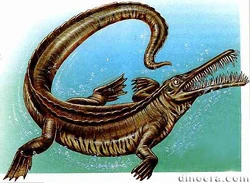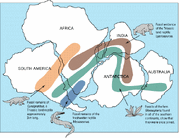| Mesosaurus Fossil range: Early Permian | |
|---|---|
 Artist's restoration of Mesosaurus. | |
| Scientific classification
| |
|
Mesosauria | |
|
Mesosauridae | |
|
Mesosaurus Gervais, 1864-66 | |
| |
Mesosaurus is an extinct genus of anapsid reptile from the Early Permian period of southern Africa and South America, once recently Ditrochosaurus.
Description[]
Mesosaurus had a long skull that was larger than that of Stereosternum and had longer teeth. The teeth are angled outwards, especially those at the tips of the jaws.[5]
The bones of the postcranial skeleton are thick, having undergone pachyostosis. Mesosaurus is unusual among reptiles in that it possesses a cleithrum. A cleithrum is a type of dermal bone that overlies the scapula, and is usually found in more primitive bony fish and tetrapods. The head of the interclavicle of Mesosaurus is triangular, unlike those of other early reptiles, which are diamond-shaped.
Paleobiology[]

Skeleton of Mesosaurus
Mesosaurus was one of the first reptiles to return to the water in which its amphibians ancestors originally lived. It was around 1 meter (3.3 ft) in length, with webbed feet, a streamlined body, and a long tail that may have supported a fin. It probably propelled itself through the water with its long hind legs and flexible tail. Its body was also flexible and could easily move sideways, but it had heavily thickened ribs, which would have prevented it from twisting its body.[1]
Mesosaurus had a small skull with long jaws. The nostrils were located at the top, allowing the creature to breathe with only the upper side of its head breaking the surface, in a similar manner to a modern crocodile. Its most striking feature were its numerous, thin teeth. Each tooth had its own socket, but they were too thin to catch prey. Instead, they are thought to have been used to filter plankton from the water.[1]
Distribution[]

Location of Mesosaurus remains shown in blue.
Mesosaurus was significant in providing evidence for the theory of continental drift, because its remains were found in southern Africa and eastern South America, two far away places. As Mesosaurus was a freshwater animal, and therefore could not have crossed the Atlantic Ocean, this distribution indicated that the two continents used to be joined together.
References[]
- ^ a b Palmer, D., ed (1999). The Marshall Illustrated Encyclopedia of Dinosaurs and Prehistoric Animals. London: Marshall Editions. p. 65. ISBN 1-84028-152-9.
- Carroll, R. L. (1988). K. Behrensmeyer/K. Behrensmeyer/J. Alroy. ed. Vertebrate Paleontology and Evolution. W.H. Freeman and Company.
- Sepkoski, J. J. (2002). "A compendium of fossil marine animal genera". Bulletins of American Paleontology 363: 1-560.
- Modesto, Sean Patrick (March 2006). "The cranial skeleton of the Early Permian aquatic reptile Mesosaurus tenuidens: implications for relationships and palaeobiology". Zoological Journal of the Linnean Society (Blackwell Publishing) 146 (3): 345-368. doi:. http://www.ingentaconnect.com/bsc/zoj/2006/00000146/00000003/art00002.
- Margulis, Lynn; Clifford Matthews and Aaron Haselton. Environmental Evolution: Effects of the Origin and Evolution of Life on Planet Earth. Contributor Clifford Matthews, Aaron Haselton (2nd ed.). pp. 338. ISBN 0262631970, 9780262631976.
- LeGrand, Homer Eugene (1988). Drifting Continents and Shifting Theories: The Modern Revolution in Geology and Scientific Change (illustrated ed.). Cambridge University Press. pp. 313. ISBN 0521311055, 9780521311052.